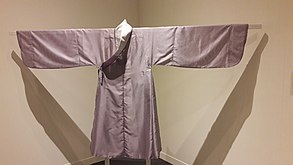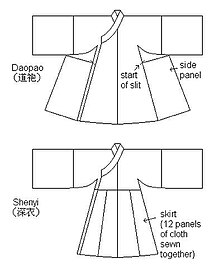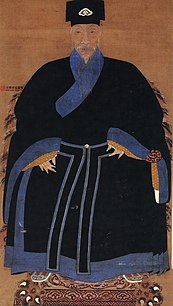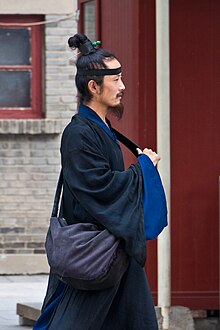Daopao
[citation needed] Initially the daopao was a form of casual clothing which was worn by the middle or lower class in the Ming dynasty.
[1] In the middle and late Ming, it was one of the most common form of robes worn by men as casual clothing.
[8] The daopao was also introduced in Korea during the Joseon period, where it became known as dopo and was eventually localized in its current form.
[9] The daopao can also refer to a type of Daojiao fushi, which were worn by practitioners of taoism, when the term is used in its literal form.
Some sources posit that a form of daopao without a cord had evolved from the kuzhe, which refers to the military-style garments which had supposedly been influenced by the northern nomad warriors from the north in the past.
[citation needed] After the year 960 AD, the belted daopao was worn by the Taoist priests in order to distinguish themselves from others.
[18] The broad and elegant robes which were initially worn by Taoist priests were known as the daofu (Chinese: 道服; pinyin: dàofú; lit.
[20]: 94 During this period, the daofu also became very popular and was greatly appreciated by some hermits and scholars during the Song dynasty and was mentioned in some poems written by Wang Yucheng and Fan Zhongyan.
[19]: 22 In Volume 2 of the chapter Xuezhai zhanbi《学斋占毕》in the Yinshi yifu jinjiebiangu《飲食衣服今皆變古》, Shi Shengzu reported that the daofu had been made popular by the use of guan and the shoes called lü; he associated the reason behind the popularity of daofu with the attire style of the Taoist priests, which he observed, had remained unchanged for centuries.
[19]: 22 He also concluded that the apparel system of the three ancient Chinese dynasties, referred collectively as the Sandai (三代), could still be found among the attire-style of the Taoist priests.
[4] It characterized by a cross collar, which closes at the right side in the front, in a style called jiaoling youren.
[21] The Ming dynasty daofu was similar to the daopao, except for the addition of edges decoration on the robe.
[2]: 77, 181 When used in Chinese opera, the xuezi is a form of informal dress worn by performers who hold the sheng role types, which include the xiaosheng[22]: 31–32 and the wenxiaosheng.
[22]: 3 Performers playing female roles could also wear a xuezi called nüxuezi, which was also used as an informal robe.
[24] According to the Joseon literati, Sŏng Tae-chung, who visited Japan in the 1764 at a time when the Ming dynasty had already fallen, when asked what he wore as a robe and headwear by Ryūzan, Sŏng Tae-chung answered that he was wearing the dopo and the bokgeon which were the attire of the ancient sages 《冠幅巾衣道袍, 乃古聖賢所着》; the dopo and bokgeon were both Confucian attire and dressing style which had been adopted in Joseon.
[25] The traditional taoist robes can also be worn as a daily lives clothing by the Quanzhen monastics in mainland China.
[6] It is worn by middle-ranks Taoist priests; it is red in colour and has motifs at the back and front, on the sleeves.
It looks similar to a poncho in structure;[6] when worn, the robe sits squarely on the shoulders of the Taoist' priest; it is usually fastened across the front with two silk ties which are sewn just above the waist level.
[30]The Quanzhen monastic taoist priests and nuns wear a wide-sleeved, cross-collared gown called daoyi (道衣; lit.
[28] The blue colour is a symbolism for the east and represents having been descended from the first patriarch of the Quanzhen school, Donghua dijun.
[7] In the Wengong temple in Hanzhong, the cross-collar daopao is the standard form of attire and is referred as daogua (Chinese: 道褂; lit.









